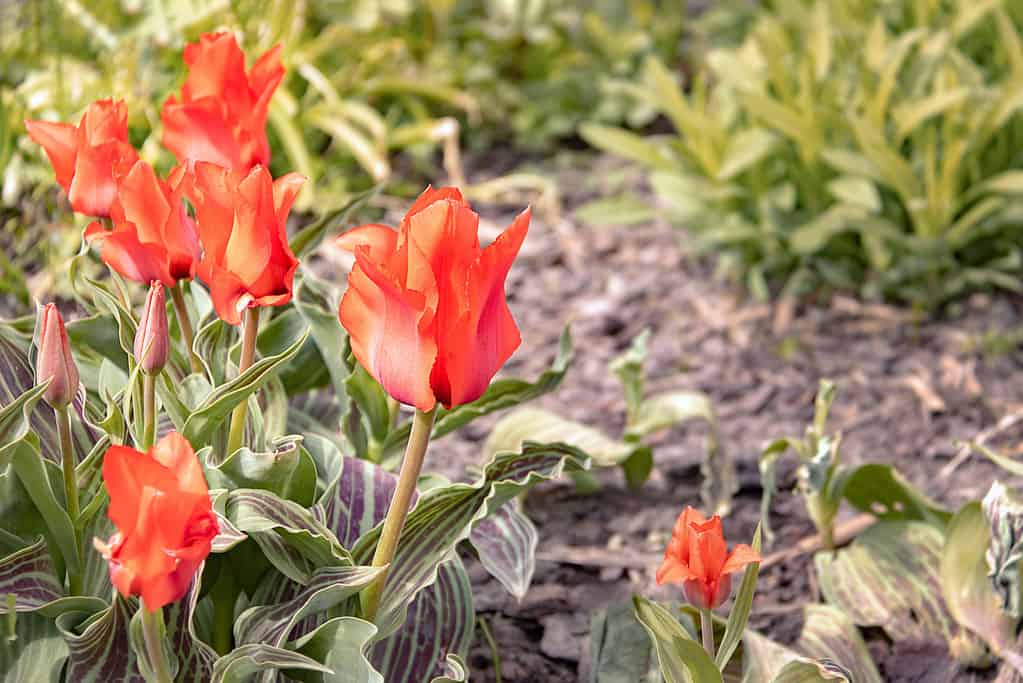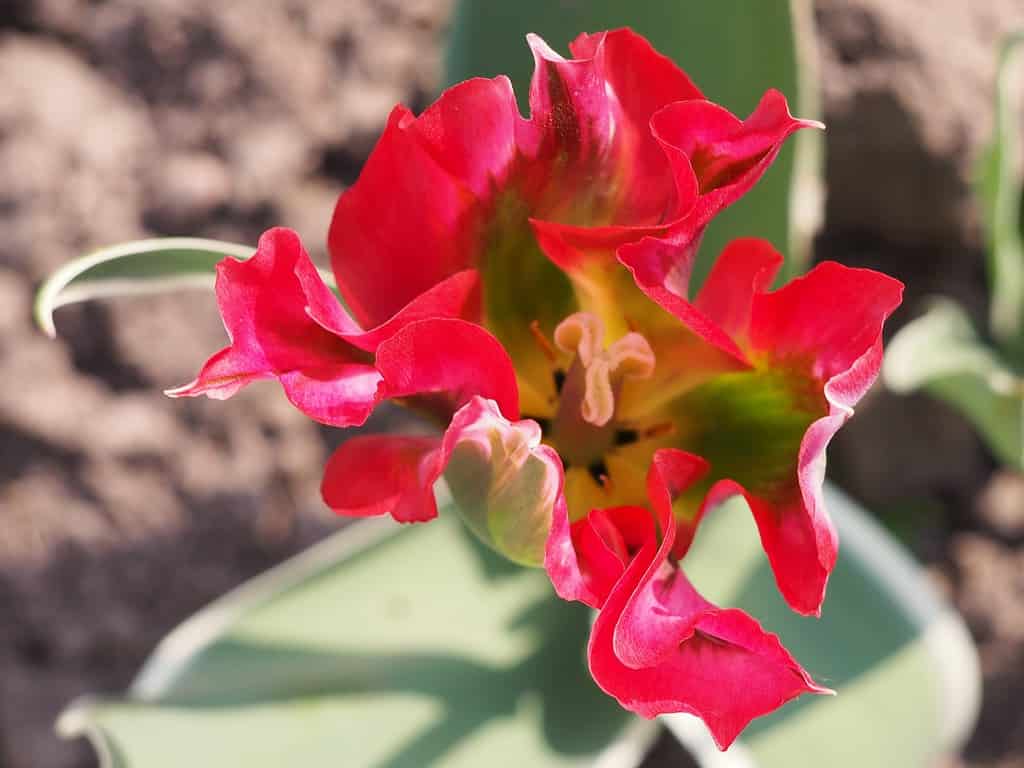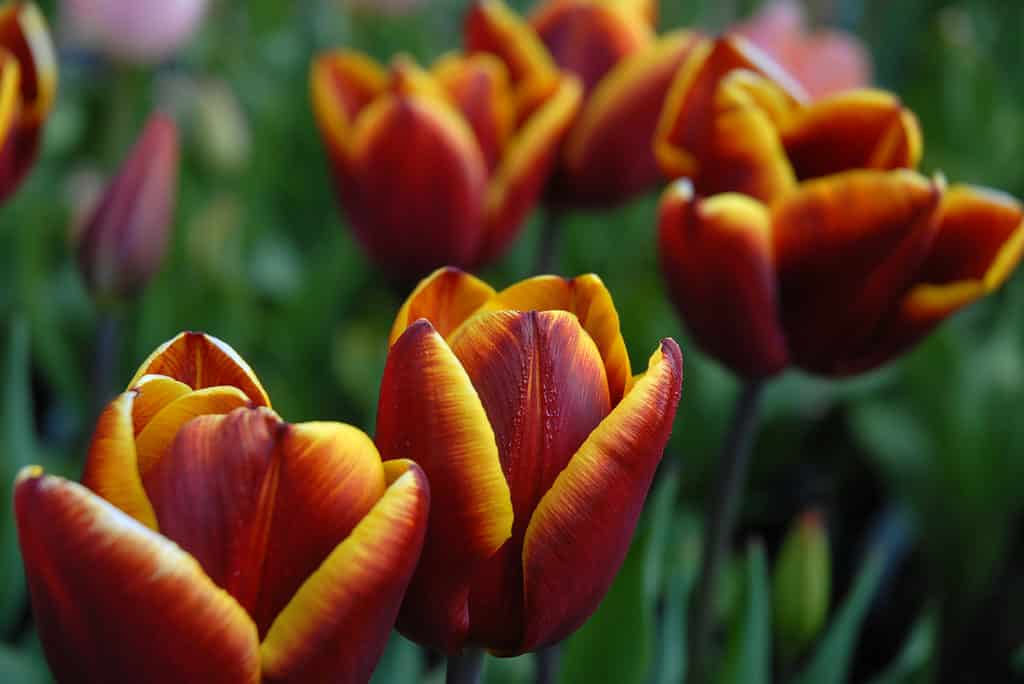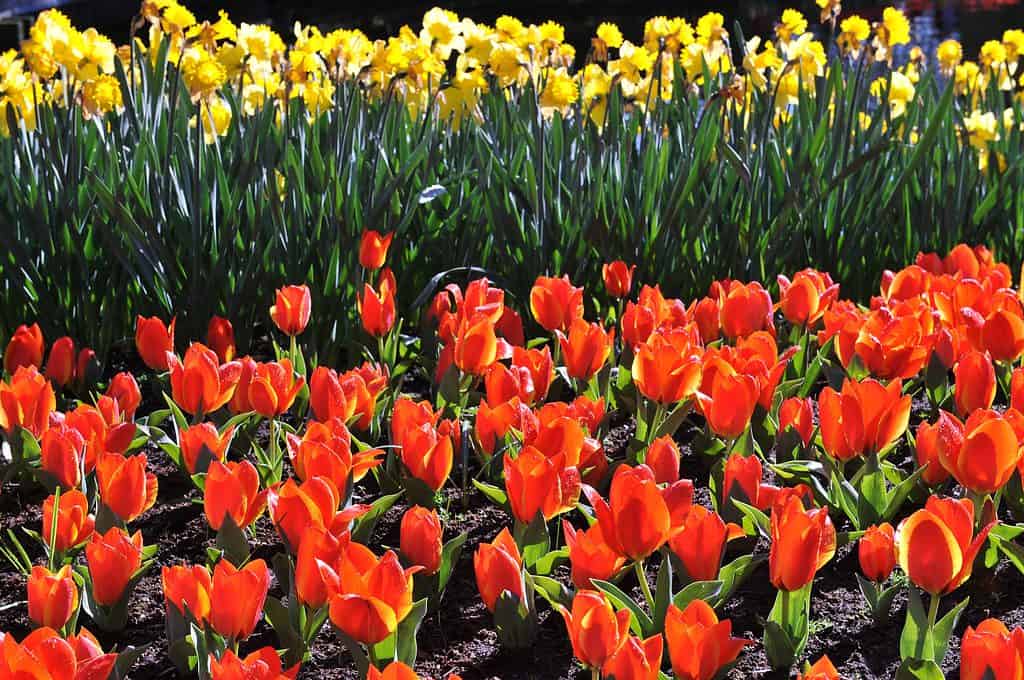Nothing says spring quite like colorful, cup-shaped blossoms sprouting from the earth after a long, cold winter. South Dakota is no stranger to cold winters, and luckily for midwestern gardeners those tulips need lengthy cold conditions in the soil to flourish. If you’re considering which tulips to grow in South Dakota this year, look no further as we’ll discuss which tulips to grow, how to plant and care for them, when they bloom and more.
3 Tulip Types to Grow in South Dakota
When planning to grow tulips in your South Dakota garden you’ll have a staggering array to choose from. While the classic cup-shaped tulip is the most well known, there are some serious variations in size, shape, petal quantity and color. In fact, there are an excess of 3,000 tulip variations. These are divided into 15 groups by the Royal General Bulb Growers’ Association (known by the Dutch acronym KAVB) of the Netherlands based on flower type, blooming period, heritage and other characteristics.
So, which tulips are best for South Dakota planting? As we’ll discuss in detail, tulip bulbs need a cold period for proper development and robust blooms. All regions of South Dakota experience cold winters and any variety of tulip can grow well. We’ll hone in on 3 types of tulips to grow in South Dakota and get you prepared for a beautiful spring season.
1. Greigii Tulip Group
Tulips within this group bloom in early spring. Petals of most varieties are either mottled or striped and they often have wavy and sometimes multi-colored leaves that spread upon the ground. They typically have relatively large blooms atop short and sturdy stems. Greigii are sometimes called dwarf tulips and their compact size makes them a good candidate for container gardens, but rock garden, border and bed plantings work well too.
Tulipa greigii ‘Red Riding Hood’ is a spring stunner with large red blooms and variegated green and purple leaves. ‘Engadi’ is a variety with deep red flowers that feather into yellow edges. Their petals have yellow interiors streaked with red and variegated leaves. ‘Giant Orange Sunrise’ is a bold orange blossom and ‘Pinocchio’ petals are candy red with cream edges.

‘Red Riding Hood’ produces beautiful, large red blooms and variegated green and purple leaves.
©iStock.com/Irina Filatova
2. Viridiflora Tulip Group
Viridi is Latin for fresh and green, making viridiflora a fitting name for these green-tinged spring flowers. They’re almost entirely green when the buds first emerge but later develop a second base color. They grow stems of various lengths and are late bloomers. The form that the flower takes on can vary from those of the single, double, lily-shaped and parrot blossoms. An excellent choice to cut for bouquets as the blooms are long-lasting.
Tulipa viridiflora ‘Esperanto’ features pinkish red petals streaked with the characteristic green while ‘Orange Marmalade’ is a blend of green with bright melon orange, pink and yellow. ‘Green Spirit’ is a striking viridiflora with creamy white petals streaked with a lime green accent. This interesting feature gives a really unique sense of the stems and foliage blending into the petals.

‘Esperanto’ features pinkish red petals streaked with the characteristic green.
©Agnieszka Kwiecień, Nova, CC BY-SA 4.0 via Wikimedia Commons – License
3. Triumph Tulip Group
Tulips of this group are the result of a cross between excellent early and late blooming groups. These mid-season bloomers erupt in bold and beautiful colors atop mid-length stems. Their blooms have a classic cup shape with compact, slightly pointed or flared petals. They are excellent for borders, beds, containers and bouquets.
Tulipa triumph ‘Peppermint Candy’ looks just like it sounds with petals of white streaked with pink. The pink stripes widen with the blooms age. ‘Beautytrend’ is similar but with fuzzy edges and pointed petals. ‘Golden Prins Claus’ really shines with golden buttercup-yellow blooms.

Triumph tulips are a cross between excellent early and late blooming groups, producing bold and beautiful colors atop mid-length stems.
©Josie Elias/Shutterstock.com
Are Tulips Annuals or Perennials?
The ancestors of modern-day tulips are wildflowers of the steppes and mountains of central Asia. These short-stemmed tulips grew hardy and strong in the sandy soils of their native habitat and returned year after year as perennials. You can still grow Species tulips today but the majority of tulips are hybrid types.
Hybridized tulips have been developed for their ostentatious displays in the spring garden. However, their flashy forms take a lot of energy for the plant to produce. So, although tulips are technically perennials the average lifespan of a tulip bulb is 2-5 years. Many tulips growers treat them as annuals, since their performance after the first year can be diminished, especially without proper care. Midwestern growers can choose to grow their tulips as perennials or annuals depending on their preference and growing conditions.

The majority of tulips are hybrid types developed for their ostentatious displays.
©Printemps PhotoArt/Shutterstock.com
Tulip Life Cycle is Temperature Dependent
Temperature is the most important factor for tulip planting, growth and blooming. Their annual cycle follows a pattern of warm-cool-warm:
When the bulbs are planted in the fall, cool soil temperatures allow for proper root development. Tulips then need prolonged exposure to cold conditions and Midwest gardeners are fortunate to achieve these conditions naturally due to the climate. The ideal range of 35 to 45 degrees Fahrenheit temperatures beneath the soil to initiate flower formation. The soil insulates the bulbs and protects them from extremely cold temperatures. As soil temperatures reach 50 degrees and higher during the spring, the flower matures within the bulb. Once temperatures are in the low 60s, the stalk climbs skyward and bursts forth in elegant bloom within 3-4 weeks.
Light spring snowfalls are not uncommon in many regions of South Dakota but don’t let shifting spring temperatures worry you. Tulips foliage and closed flowers can withstand a light freeze now and then. Long periods of freezing temperatures, 24 hours or more, can result in damage to your developing tulips. Yellow or white patches on tulip petals or foliage are signs of freeze damage, but don’t cut them back unless completely wilted since photosynthesis of the healthy areas will be important.

Light spring snowfalls are not uncommon in many regions of South Dakota, but tulip foliage and closed flowers can withstand a light freeze.
©iStock.com/johny007pan
When to Plant Tulips in South Dakota
Summer is a great time to begin the exciting process of selecting which colors and shape will dot your landscape. Order your bulbs from a reputable source or visit a local farm or garden center to see what they have available and ask for recommendations.
Tulips thrive in planting Zones 3-7 and since all of South Dakota falls within that range, you can successfully grow tulips in any region in South Dakota. Just double check that the bulbs you choose are cold hardy to the Zone where you live. Tulip planting time for South Dakota gardeners will fall between mid-September to mid-October. Plant tulip bulbs in the fall when soil temperatures are staying in the 40 to 50 degrees Fahrenheit range. Check the predicted freezes for your region and aim to get your bulbs in the ground roughly 6-8 weeks before a hard freeze is expected.

You can successfully grow tulips in any region in South Dakota.
©Sergey V Kalyakin/Shutterstock.com
How to Plant and Care for Tulips
Take care in choosing your planting location. Tulips will do best when their chosen area receives at least 6 hours of direct sunlight per day, especially if you want them to return vibrant the following year. Partially shaded areas may work as well if you have limited sunlight. Your soil should be rich with organic matter and well draining. Add compost or other amendments if needed.
Dig holes for your bulbs that are 2-3 times as deep as the bulb is tall. This will be a depth of 6-8 inches for most varieties. In clay heavy soils you’ll want to plant them 1-2 inches shallower to give the shoots an opportunity to emerge from the soil without excessive effort. Space the holes roughly 3-8 inches apart. Tulips look best planted in clusters and not in straight rows. As you place the bulbs in their holes be sure to have the pointed end of the bulb facing up. After covering the holes with soil add a 2-3 inch mulch layer or shredded bark or straw on top. This will protect the bulbs from extreme temperatures and retain soil moisture. If necessary, lay down chicken wire to prevent the bulbs being dug up by hungry deer or rodents.
Directly after planting water the area once thoroughly to wake the bulbs up and then you can generally leave them alone until springtime. If your area experiences a long drought, water again to maintain moisture.

When planting tulip bulbs be sure to have the pointed end of the bulb facing up.
©Natallia Ustsinava/Shutterstock.com
When Do Tulips Bloom in South Dakota?
Bloom time will be mostly dependent on bulb type. Tulips from the Greigii group will flower in the early spring, Triumphs are mid-season bloomers and Viridiflora types will emerge late in the season. The growing environment will also have an impact. Warmer sheltered locations, such as beds up against buildings will act as a heat reservoir and the flowers there may emerge earlier.
After putting on a show of brilliant forms and hues for the season, your tulips will begin to wilt. If you’ll be treating your tulips as annuals, simply dig them up and compost the bulbs to leave room in the beds for next season.
If you’ll be pushing your bulbs to perennialize, clip the flowers from the stalks and let the leaves grow. Clipping the flowers prevents the plant from spending energy producing seed. The leaves allow the plant to continue gathering energy for another season. Once the foliage has yellowed and gone completely limp, you can remove it. To prevent crowding over the course of several seasons, the bulbs can be dug up and divided. Store the best bulbs in a cool, dry location for replanting the following year.
Tulip Festival in South Dakota
Every spring the grounds of McCrory gardens come to life with a dazzling display of spring blooms, including thousands of tulips. The annual Tulipalooza festival is a celebration of spring and offers visitors a chance to browse the 25 acres of flowers at the gardens. McCrory gardens are part of South Dakota State University in Brookings. This botanical garden is open year-round, but May is the best time to view the tulips in bloom. Whether you’ll be growing your own tulips this year or just want to know where to view some of the best blooms in South Dakota, you won’t want to miss this event!
The photo featured at the top of this post is © dariapine /Shutterstock.com
Thank you for reading! Have some feedback for us? Contact the AZ Animals editorial team.






